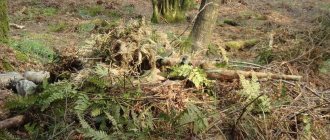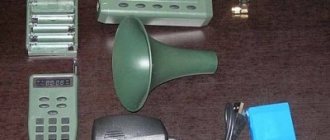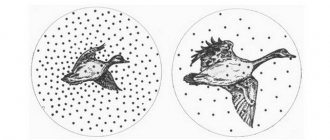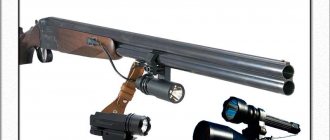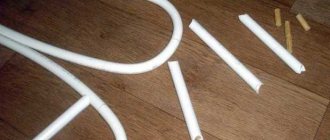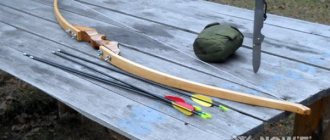- November 26, 2018
- Weapons and ammunition
- Tamila Gresko
According to experts, the successful outcome of the hunt directly depends on how the shooter is camouflaged and how comfortable he is. To remain invisible to game, a special device was invented, known as a hunting concealment. Today these products are available in specialized stores. With their help you can catch any game, including ducks. However, it is not at all necessary to become the owner of a branded stealth. Judging by the reviews, many hunters prefer to use handicraft products. In this case, the hunter has the opportunity to take into account individual parameters. It’s not difficult to make a duck hunting hide with your own hands. It is enough to use natural materials characteristic of the area. Information on how to make a hide for duck hunting is contained in this article.
Getting to know the device
A hunting hide, or hide, is a special structure from which it is convenient for the shooter to carry out observation. The place should be as comfortable as possible and hide the hunter. Mostly a hunting hide is a hut. The material used for its production is hay, grass and branches. A duck hunting hide can also be built on the water. Camouflage is carried out through bushes or thickets. Read on to learn more about how to make a concealment for hunting.
Camouflage for placement on land
You can make a secret with your own hands in advance or directly on the spot. This is a creative and exciting process.
Net
Concealment net
It is best to use viscose thread as a base; it is quite light and practical; jute cord will also work.
Do-it-yourself weaving is a rather lengthy and labor-intensive process.
You can use bobbins or shuttles with a template. If you have a ready-made fishing or volleyball net, this will be the best option; the base can also be found in any specialized store. It's inexpensive.
Next, to the finished base you need to sew: pieces of old camouflage fabric, tufts of dry grass, reed leaves and other materials that will more accurately correspond to the area where the hunt will take place.
It is best to have two or three network options:
- in green - for camouflage in the swamp;
- in gray - against the background of reeds;
- in dirty yellow, sand - for dry grass.
The mesh prepared in advance at the hunting site must be supplemented with the vegetation that will surround it - this way you can better merge with nature and the duck will not notice the difference. You need to make sure that there are no foreign objects around the hide: it happened that a forgotten pack of cigarettes scared the duck away.
Aluminum frame for a tent
Tent
Easy to make with your own hands using a frame and mesh. Thin metal or plastic rods are used as a frame; you can use the frame from an old tent. A mesh is put on it. Its dimensions must correspond to the base.
As an option to disguise yourself as dry grass or a haystack, it is appropriate to use jute threads, hanging them on a mesh in several layers so that the tent does not show through. When manufacturing, it is necessary to be guided by the rule - to match as closely as possible to the place where the hide will be placed.
Further, a full flight of imagination is allowed in the search for materials:
Tent
- fabric strips;
- old worn camouflage clothing;
- flax sponge;
- rope tow;
- rags;
- moss;
- dry grass;
- thin branches.
The tent is very convenient for duck hunting, it is easy to assemble and disassemble, the weight of the structure is small, and it is most suitable as a hideout in bushes or reeds.
Trench
Skradok - trench
It is also the most common hide for duck hunting. It is convenient and simple, allowing you to get the duck as close to you as possible. The only negative is that you will have to dig (on average, it will take two hours to equip it, depending on the soil). The required tool is a bayonet shovel. The size of the handle should be selected based on the size of the bag or trunk; birch is best.
Having decided on a location, they begin digging. You should start with an oval shape, but try not to expand it.
The length and width are selected based on your own dimensions (a person will be positioned in a trench in a squat). For convenience, a step is made, such a height that when you bend over, your head is not visible, but when you stretch your neck, you have a good view.
When digging a trench, there is one caveat: the earth must be scattered as far as possible, in a fan, so it will not attract the attention of the bird.
Once the desired depth has been achieved, masking begins. A groove is made along the edges of the trench, and bunches of dry grass are placed in it. The longer the stems the better, the main goal is to close the hole as much as possible. Grass and stems are sprinkled with earth and compacted; for better camouflage, you can scatter a little more around the trench.
Types of sittings
Depending on the location of the concealment, there are the following types:
- Trench. This bait is effective for field hunting or near a pond. In the second case, the depth of the concealment should not exceed one meter. Otherwise the hunter will sit in the water.
- Net. This is a universal disguise. If desired, the hunter can additionally equip it with various materials, the color of which is identical to the surrounding area. Mainly for this purpose, grass and reeds taken on site are inserted into the cells.
- Shield. This species is intended for hunting on water. The purpose of the ambush is to camouflage the boat with the shooter.
- Tent. The hunting concealment is represented by a frame on which camouflage fabric or mesh is stretched. Since the design is quite large, this blind is unsuitable for field hunting.
About the “Invisible” ambush
This is what they call a mirror hide for hunting, which is equally effective for catching both migratory birds and animals. The design has a hexagonal shape and provides a 360-degree view. When the bird approaches within shooting distance, the hunter just needs to open the cover in the blind and hit the target. The product is equipped with mirror walls (5 pcs.), one mirror door on hinges, a camouflage double-leaf lid, two tie straps and 10 pcs. of mounting pegs. The height of the entire structure is no more than 120 cm, the width is 49 cm. The shelter can be assembled in five minutes, is easily transported, and when disassembled, it blends perfectly with the terrain. To become the owner of this steal, the hunter will have to shell out 18 thousand rubles.
How to make a fence from a mesh?
This concealer is intended for use on land. You can use jute cord or viscose thread as a base. This material is lightweight and practical. Weaving is a rather long and labor-intensive, but fascinating process. For those who do not want to waste time, we can recommend purchasing a ready-made fishing or volleyball net. They are sold in specialized stores. Then the finished base is equipped with additional elements: camouflage fabric cut into several pieces, tufts of grass and leaves. In this case, you need to ensure that the stealth does not stand out on the ground. Experienced hunters recommend stocking up on three options for ambushes of this type. For example, a green shade is ideal for swampy areas. If a hunter plans to camp in the reeds, then he should use a gray mesh, among dry grass - dirty yellow and sand. In swampy areas, the hunter may have difficulties due to moisture. For this reason, it is better to line the bottom of the shelter with boards and polystyrene foam. You can also put a karimat. The whole structure will be stronger if the base of the fence is tied to wooden pegs.
How to make your own ambush
If desired, you can assemble a sitting hide for a goose yourself. To make a camouflage device you will need:
- Light metal for the frame or plastic.
- Net.
- Thick camouflage fabric.
Some masters of concealment on a goose cover it with vegetation
At the same time, it is very important that it is not thick and that the cover does not provide shade.
The main design detail is the frame. The base is required to be strong and at the same time light, because at any moment you will need to move the hide to another place. Aluminum parts or polyethylene pipes, usually used for water supply systems, are suitable for production. Light, dark material, such as spunbond, is used as a coating. A camouflage net is attached on top.
The general manufacturing procedure goes like this:
- They make a frame that is easy to assemble and disassemble. The size is calculated taking into account the height and weight of the hunter.
- Cover the base with fabric.
- Cover with camouflage mesh. Grass is used to enhance camouflage. It is evenly distributed between the grid cells.
The principle of making recumbent hides is the same. Those craftsmen who have already built shelters recommend using the aluminum frame of a clamshell as a frame.
Progress
You should start with the manufacture of the main element of the shelter - the frame. It is made from lightweight but durable material. You can use plastic pipes, which are connected with special fasteners and soldering.
Some home craftsmen use old folding beds for this purpose, namely aluminum tubes. You can add rigidity to the structure using corners and fasteners with bolts. To ensure that the disassembled dimensions of the structure are insignificant, experts recommend using not solid tubes, but their sections connected by tubular locks. Then a woven mesh is pulled over the finished frame. The tent will not be transparent if the net on it lies in several layers.
How to make a hole in the ground?
Concealments in the form of trenches, judging by numerous reviews from hunters, are very common. They are convenient, simple and allow you to bring game closer to the shooter. The only disadvantage of trenches is that you have to dig the ground to make them. It will take approximately two hours, or even more, to set up such a stand - it all depends on what kind of soil you have to deal with.
You need to work with a bayonet shovel. First you need to decide on a place to hang out. They dig it in such a way that the oval shape is maintained. There is no need to expand; on the contrary, the secret should deepen. In order not to attract the attention of birds, the earth should be thrown as far as possible. The depth of the seat should be such that the shooter can sit in it freely. For this purpose, the trench is equipped with a step. The hide is considered to be performed correctly if the hunter's head is not visible in a bent position. Next, a ditch is dug at the edges of the trench, into which dry grass is then placed. Several bundles are first formed from it. It is best to use grass with long stems - the dug hole will thus be covered as much as possible.
Choosing a warehouse location
The most important thing that you should pay attention to when choosing a place to place a hunting storage shed is that the smell of the person who is in the “blanket” is not sensed by the animal. It should be noted that this is not very easy to do, since both predators and ungulates have a narrow, penetrating sense.
Another fundamental condition for successful hunting from a storage shed is the absence of rustles and noises that could give away the one who is sitting in ambush. Absolute silence while waiting for the animal for quite a long and often grueling time is a very important moment in the hunt.
By the way, a storage shed is not always located at a height. From time to time, a “hideout” can be arranged directly on the ground. Of course, it is necessary to make sure that the hunter will not be identified by smell and the animal will not suddenly appear behind him. The edge of the field, which goes around the bend of the river, can be considered a common example of a good location for a storage shed. Usually the wind blows along the river in the evening, which will neutralize the hunter's smell. Hiding at such a bend on the leeward edge, you can calmly lie in wait for prey.
A barn or an abandoned house located on the outskirts of a village can also become a storehouse. Other options are a mop of grass or a haystack located at the edge of the field. It should be remembered that an impeccable place is one where the animal cannot suddenly turn around and smell the hunter’s scent.
The most common location for a storage shed for hunting is on a tree. This "staying" method is very successful. Even the most cunning animal does not recognize or smell it.
About camouflage for water hunting
The duck is a waterfowl. Therefore, many hunters prefer to catch it on the water using boats and decoy birds. Of course, you can use thickets and reeds as shelter. But such places on reservoirs are rare. Due to this fact, hunters are forced to camouflage their boats. To do this, the bow part is wrapped with reeds. The sides of the boat are equipped with metal rods (4-6 pieces), to which a net is tied. The result should be a structure in the form of a hut or tent. No more than three people can be inside. Next you need to make shields. They are made as follows: they tie reeds and meter-long branches of bushes into bundles using wire or nylon.
Then the bundles are attached to the base and top of the hut at a distance of 150 mm. from each other. In order not to waste time, experienced hunters recommend partially driving the boat into the thickets. As a result, only its rear part and one side will have to be masked.
Camouflage for water hunting
The duck is a waterfowl, so hunting is often carried out from a boat, using decoy birds (real or artificial) as bait. How to hide the boat in this case? The easiest way is to hide in thickets or reeds. But in open water such a place is difficult to find. Therefore, you will have to camouflage the boat.
Shield-shield for a boat
There are two options for this:
- net;
- shields
You can make the mesh yourself, with your own hands, or purchase a ready-made one in the store. You just need to choose the right color so as not to stand out too much from the surrounding nature. It is best to use green camouflage colors - in swampy areas there is a lot of greenery and the camouflage will be less noticeable.
The bow of the boat can be completely wrapped in reed leaves, which can also be used as additional camouflage. To make it comfortable to sit, metal rods are installed on the boat on four sides. Six can be used, depending on the design of the craft. A net is hung on them - it looks like a tent or hut. This design is comfortable for two or three hunters.
Hunter in a boat with a shield
Shields are made with your own hands at the hunting site. Shrub branches or reeds can be used as material. The length of the stems should be more than one meter. The bundles are tied together with nylon rope or soft wire. It is better to tie adjacent bundles in two places - at the base and at the top, retreating 15 cm.
Depending on the size of the boat, you will need 3-4 shields.
It is convenient to make them small, up to 0.5 m wide. Each should be attached to a long stick, which is then driven into the bottom of the reservoir.
To save time on making shields, you can drive the bow of the boat into reeds or thickets of coastal bushes, so that only the stern and sides will have to be covered. This hide will be as realistic as possible - you can let a duck get quite close to it, especially if you use decoy birds.
